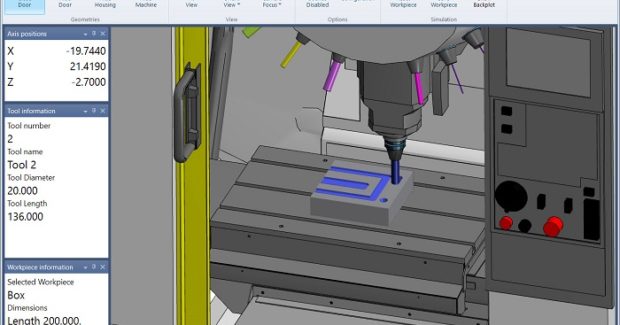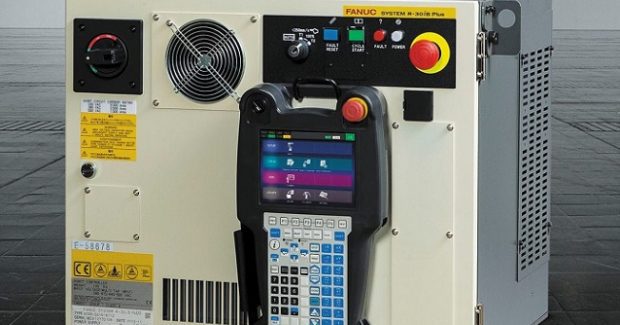Integrate Part Design to Production Through Machining Simulation
The Machining Simulator from FANUC integrates the complete manufacturing process through Autodesk Fusion 360 CAD/CAM/CAE software and a custom ModuleWorks program for toolpath generation and machining simulation.
Posted: March 9, 2018
A machining simulator from FANUC America Corporation (Rochester Hills, MI) encompasses the complete manufacturing process from part design and engineering to CNC programming to virtual production simulation: The Machining Simulator features Fusion 360 CAD/CAM/CAE software from Autodesk Inc. (San Rafael, CA) and a custom machining simulation program designed by ModuleWorks GmbH (Aachen, Germany), a leading supplier of CAD/CAM components for toolpath generation and simulation. Fusion 360 is a cloud-based 3D CAD, CAM and CAE software platform that helps bridge the gap between design and machining and works on both Mac and PC. Students can use Fusion 360 to perform CAD/CAM work and the included post processors will convert the designs into G-code suitable for the included CNC. The CNC will use this G-code to command the machine tool. This simulation system also includes a simple G-code editor for making modifications before the program is sent to the CNC. Students can easily import their programs directly to the CNC using the FASBacCNC user interface and also back-up the critical CNC data.
The core of this system is the flexible, portable and powerful CNC Simulator that provides users with the experience of working with real look and feel of a true hardware-based control. Based on the industry standard 0i-Model F, this simulator can be operated as either a 3-axis mill or a 2-axis lathe. Users can run programs, manage tooling and make any modifications on the control just like they would in a manufacturing environment. The CNC Simulator includes Manual Guide i conversational programming software for users who would like to learn shop floor programming. An integrated PC is embedded in the simulator to run the Fusion 360 and ModuleWorks simulation software. Users can virtually manufacture parts in milling or turning environments with realistic kinematics and structure.
The simulation is based on actual CNC position data, not on the G-code program. This provides the most realistic simulation because the virtual machine reacts exactly as a real machine. Manual machine functions such as jog, hand-wheel and reference cycles also work exactly like a real machine. The software also uses color-coded tool paths, back-plot and cut locations to make it easy for users to identify the tool, path and cutting result. Real-time collision detection uses visual and audio signals to notify users of collisions. The milling simulation includes a 21-tool changer and the turning simulation includes a 12-tool turret. Milling tool data can be freely assigned or imported from the CNC Simulator, while turning uses a predefined set of turning tools that cover a wide range of applications. Fusion 360 is free for students, startups, educators and hobbyists once they create an Autodesk account. Commercial users can sign up for a free one-year subscription through a special promotion with FANUC.
FANUC America also offers their R-30iB Plus controller that features an iPendant with enhanced screen resolution and processing capability. The user interface, iHMI, has an icon-based screen that provides a familiar and easy-to-use experience with intuitive guides for setup and programming. It also includes tutorials from the main home page which has a design common to FANUC CNCs, enabling easier use of robots. With the help of the programming guide, even first-time robot users can create a program for a simple handling task and execute it in just 30 minutes. Easier usage also facilitates system setup and maintenance to improve efficiency. For those users that are more comfortable with the current interface, this new iPendant can easily revert to the previous version.
Processing performance for both hardware and software has been improved in the R-30iB Plus and the signal processing cycle has been shortened. Compared to past controllers, signal output timing has been enhanced, expanding possible applications to systems which require a high level of positioning precision, such as laser applications. The vision function of R-30iB Plus has a camera interface that increases four times the speed for transmitting images from the camera, together with a simplified cable configuration. With improvements in the user interface, the setup of the vision system can be handled much more efficiently. Overall, R-30iB Plus contributes to the easier use of robots and automation in the manufacturing industry.
FANUC America Corporation, 3900 West Hamlin Road, Rochester Hills, MI 48309, 248-377-7000, www.fanucamerica.com.












